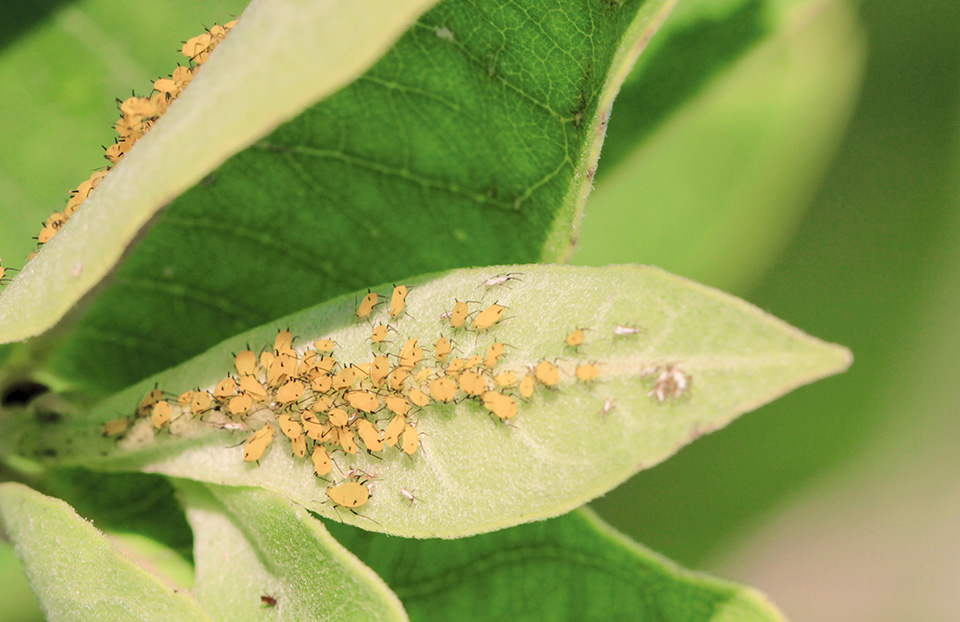
(Photo: Tech&Learn.com/sock.adobe.com)
Controlling resistant pests
December 1, 2023
By Laura Temple, Soybean Research & Information Network
Soybean aphids, like many pests, are developing resistance to primary control options. Researchers have confirmed that populations in southern Minnesota and northern Iowa have become less susceptible to pyrethroid insecticides.
To better understand this threat, Matt O’Neal, professor of entomology at Iowa State University, collaborated with colleagues and students to apply genetic tools to this challenge. His efforts build on earlier research funded by the soy checkoff, and the Iowa Soybean Association is funding this research.
“Aphid populations were low in the northern third of Iowa where we collected samples in 2021 and 2022, but our observations suggest that they increased following a foliar insecticide,” says O’Neal. “Populations were below treatment thresholds, so there was little risk of yield loss from the aphids. But this insecticide application increased the risk of resistant aphids spreading, making a bad situation worse.”
Economic research funded by the North Central Soybean Research Program explored the cost of pyrethroid-resistant aphids. In the long run, applying a preventative insecticide could be more costly than not spraying.
“Because pyrethroids cost less than other insecticides, switching to another chemical too soon will cost farmers,” he explains. “But, if farmers don’t switch modes of action when pyrethroid resistance appears, they could lose 25-45% in soybean yield to an outbreak of resistant aphids.”
The goal of his research is to help farmers figure out when aphids in their fields carry insecticide resistance. As the work has progressed, his team is also exploring ways to maintain the effectiveness of pyrethroids, the most cost-efficient chemical control option.
Finding resistant aphids
How do farmers know if pyrethroid-resistant aphids infest their soybeans? Answers lie in their genetics.
“Building on work funded by the soy checkoff to sequence the soybean aphid genome, we’ve identified four genetic mutations in soybean aphids that explain pyrethroid resistance in aphids,” O’Neal reports.
His team worked with U.S. Department of Agriculture (USDA) research geneticist Brad Coates, Ph.D., to develop a probe to test if aphids carry those mutations. While they have successfully identified mutant aphids from samples in the lab and field, they hope to come up with a more rapid option. The ultimate goal is to provide a simple in-field test farmers or crop scouts can conduct easily. Detecting the prevalence of resistance would support their decision-making process for applying — or not applying — insecticides.
“We’ve found that refining this test is complicated because aphids may have multiple mutations,” he says. “Once we refine the test for in-field use, we will look for an industry partner interested in making such a test available to farmers.”
Restoring pyrethroid susceptibility
Coates also shared interference RNA tools, or RNAi, with O’Neal’s team. RNAi essentially silences specific genes, and the technology has been used against other damaging insects, like corn rootworm.
“With RNAi, we are exploring if we can make pyrethroid-resistant aphids susceptible to those insecticides again,” O’Neal explains. “If we add RNAi that silences the genes carrying mutations to a pyrethroid insecticide, the hope is to control both susceptible and resistant aphids.”
He says preliminary data shows that this approach has potential. Using RNAi could also prevent further insecticide resistance from developing.
“We are trying to tackle a difficult problem, since pyrethroids are the cheapest option we have not just for aphid control, but for broad-spectrum insect control,” he says. “RNAi may help preserve the tools we have.”
He believes this approach could apply to pests beyond the soybean aphid. Results from this collaborative research could inform future research for managing the long list of insects that have become resistant to insecticides.
Learn more about this project and others at soybeanresearchinfo.com.
Back